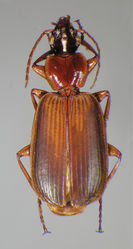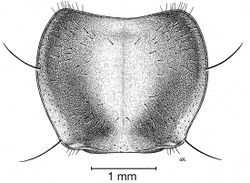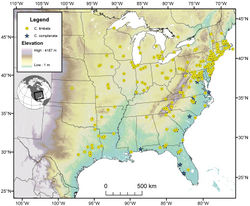Cymindis complanata
| Notice: | This page is derived from the original publication listed below, whose author(s) should always be credited. Further contributors may edit and improve the content of this page and, consequently, need to be credited as well (see page history). Any assessment of factual correctness requires a careful review of the original article as well as of subsequent contributions.
If you are uncertain whether your planned contribution is correct or not, we suggest that you use the associated discussion page instead of editing the page directly. This page should be cited as follows (rationale):
Citation formats to copy and paste
BibTeX: @article{Hunting2013ZooKeys259, RIS/ Endnote: TY - JOUR Wikipedia/ Citizendium: <ref name="Hunting2013ZooKeys259">{{Citation See also the citation download page at the journal. |
Ordo: Coleoptera
Familia: Carabidae
Genus: Cymindis
Name
Cymindis complanata Dejean – Wikispecies link – Pensoft Profile
- Cymindis complanata Dejean 1826[1]: 448. Type material (probably holotype, but without a Dejean label) in Chaudoir/Oberthür Collection, [MNHP]. TYPE LOCALITY – St. John’s Bluff, Duval County Florida, U.S.A. ; restricted by Lindroth (1969[2]: 1070) from the original type area, “L’ Amérique septentrionale”. – LeConte 1848[3]:189.
- Lebia russata Newman 1840[4]: 31. TYPE female [BMNH]. TYPE LOCALITY. – St. John’s Bluff, Duval County, Florida, U.S.A (Lindroth, 1969: 1070).
- Pinacodera complanata (Dejean, 1826); Schaum 1857[5]: 294 [as a junior synonym of Pinacodera platycollis Say].
- Pinacodera russata Chaudoir 1875[6]: 2 [as a junior synonym of Pinacodera platicollis Say]. – Lindroth 1969[2]: 1070.
- Pinacodera complanata (Dejean 1826[1]) Chaudoir 1875[6]: 2 [as a junior synonym of Pinacodera platicollis Say]. – Casey 1920[7]: 283.– Lindroth 1955[8]: 24. – 1969[2]: 1069–1070. – Ciegler 2000[9]: 119.
- Pinacodera platicollis Casey 1920[7]: 283 (not Say). – Lindroth 1969[2]: 1069.
Notes about synonymy
The above synonymy was established by Lindroth (1969)[2], though previously (1955) he treated the names Pinacodera complanata Dejean and Pinacodera russata Newman as junior synonyms of Pinacodera limbata Dejean.
Diagnosis
Adults of Cymindis complanata are distinguished from those of other species by ferruginous coloration throughout (Fig. 4) (some slightly lighter in basal third of elytra), by the almost flat elytral intervals, setae extended almost to the constriction of the elytral epipleuron; a noticeable contrast in punctation extending the length of the intervals; scattered arrangements of one to two rows on intervals 3, 5 and 7 and scattered arrangements of two to four rows in intervals 2, 4, 6 and 8 (most specimens have one row of punctures on intervals 3, 5 and 7 and 3 three rows on 2, 4, 6 and 8). In males, the endophallic plate (ep) differs as it is almost flat, and apical endophallic lobe (ael) is enlarged (Fig. 6A). In females, the form of gonocoxite 2 (gc2) differs from all other species apices of ensiform setae extend to and often past gonocoxite 2 apex (Fig. 6B).
Description
With character states of subgenus Pinacodera restricted as follows: OBL. 9.5 – 12.5 mm. Length (n= 24 males, 17 females): head 0.88–1.08, pronotum 1.72 – 2.28, elytra 5.33 – 7.17, metepisternum 1.26 – 1.64 mm; width: head 1.62 – 2.16, pronotum 2.16 – 2.92, elytra 3.58 – 5.08, metepisternum 0.62 – 0.80 mm.
Body proportions. HW/HL 1.74 – 2.08; PWM/PL 1.18 – 1.33; EL/ EW1.35 – 1.59; ML/MW 1.89 – 2.05.
Color (Fig. 4). Dorsum of head entirely ferruginous to rufo-piceous; pronotum ferruginous with lateral margins ranging from translucent to lighter and creamy in appearance; elytra ranging from ferruginous to rufo-piceous, few specimens with basal third of elytra lighter in color, lateral margins translucent to somewhat translucent; antennae and other appendages ferruginous to brown. Microsculpture. Microlines absent from head capsule and pronotum; elytra with mesh pattern isodiametric, microlines distinct.
Macrosculpture and pilosity. Dorsal punctures with short setae present, few to many visible on head, pronotum (Fig. 5), and at base of elytra (occasionally few setae extended toward apex of elytra). Elytral epipleuron with setae visible, extended to constriction. Elytral intervals with one to two rows of scattered punctures in intervals 1, 3 and 5 and two to three (rarely four) in intervals 2, 4, 6 and 8. Fixed setae. Pronotum with two setae along each margin; 15–16 lateral (umbilical) setae. Two setae on each of abdominal sterna III to VI, four setae along apical margin of sternum VII (Fig. 3).
Luster. Elytra dull.
Head. Fine scattered setigerous punctures from hind portion of eye to constriction of neck; also additional fine punctulae from base of neck extended laterally toward clypeus, otherwise glabrous.
Pronotum. Disc with setigerous punctures scattered throughout, more densely and evenly so along margins, longest setae along anterior angles (Fig. 5); posterior angles obtuse; posterior margin slightly lobate; basolateral impressions shallow.
Elytra. Elytral apices truncate, striae shallowly impressed and punctulate throughout length; intervals flat; a noticeable contrast of punctures extended interval lengths; scattered arrangements of one to two rows on intervals 3, 5 and 7 and scattered arrangements of two to four rows in intervals 2, 4, 6 and 8. Most specimens with a single row of punctures on 3, 5 and 7 and three rows on 2, 4, 6 and 8; epipleuron with setigerous punctures from base to constriction, in a few specimens beyond to apex.
Hind wings. Macropterous.
Legs. Male tarsi with adhesive vestiture ventrally, two rows of squamo- setae on tarsomeres 1–4 of foreleg and 1–3 of middle leg.
Male genitalia. (Fig. 6A) Length 1.88 – 2.00 mm. Endophallus with endophallic plate (ep) almost flat and apical endophallic lobe (ael) enlarged.
Female genitalia. Gonocoxite 2 (gc2) (Fig. 6B) distinctly, obliquely truncate.
Habitat, habits and seasonal occurrence
The known elevational range of Cymindis complanata extends from sea level to 135 m on the eastern slopes of the Appalachian Mountains. All specimens that I have collected (13 in total) were taken from slash pine (Pinus elliotii Engelm.) though it has also been recorded from under bark of live loblolly pine (Pinus taeda L.). These species of pine are very similar to each other, sharing both reddish-brown bark coloration and an abundance of flaky bark to rest under. As well, they are common within the known range of Cymindis complanata. Adults are crepuscular or nocturnal with most activity being observed on tree trunks. Most specimens have been collected in March and April. Methods of collecting include u.v. light, sugaring baits painted on tree trunks, and hand collecting at night.
Geographical distribution
The range of this species (Fig. 7) extends in the eastern United States east of the Appalachian Mountains from Maryland south to southern Florida, and westward on the Gulf Coast to western Alabama.
Chorological affinities
Cymindis complanata is sympatric in its entire range with Cymindis limbata (Fig. 7), sympatric in the northern portion of its range with Cymindis platicollis platicollis and in the southern portion of its range with Cymindis platicollis atripennis.
Material examined
I have examined 42 specimens of Cymindis complanata: 23 males and 19 females. For details see University of Alberta Strickland Virtual Entomology Museum Database (University of Alberta 2009[10]).
Taxon Treatment
- Hunting, W; 2013: A taxonomic revision of the Cymindis (Pinacodera) limbata species group (Coleoptera, Carabidae, Lebiini), including description of a new species from Florida, U.S.A. ZooKeys, 259: 1-73. doi
Other References
- ↑ 1.0 1.1 Dejean P (1826) Spécies general des coléoptères de la collection de M. le comte Dejean, vol. 2, Paris, 501.
- ↑ 2.0 2.1 2.2 2.3 2.4 Lindroth C (1969) The ground beetles (Carabidae excl. Cicindelinae) of Canada and Alaska. Part 6. Opuscula Entomologica, Supplementum 35: 945-1192.
- ↑ LeConte J (1848) A descriptive catalogue of the geodephagous Coleoptera inhabiting the United States east of the Rocky Mountains. Annals of the Lyceum of Natural History of New York 4: 173-474. doi: 10.1111/j.1749-6632.1848.tb00277.x
- ↑ Newman E (1840) Entomological notes. Entomologist No. 2, 17–32.
- ↑ Schaum H (1856–1860) (1857). Naturgesichte der Insecten Deutschlands. Erste Abtheilung. Coleoptera Erste Band. Nicolaische Verlagsbuchhandlung, Berlin, 791 pp.
- ↑ 6.0 6.1 Chaudoir M (1875) Genres aberrants du groupe des cymindides. Bulletin de la Société Impériale des Naturalistes de Moscou vol. 49, pt. 2, pp. 1–61
- ↑ 7.0 7.1 Casey T (1920) Random studies among the American Caraboidea. In: Casey TL, Memoirs on the Coleoptera, Vol IX. New Era Publishing Company, Lancaster, Pennsylvania, 133–299.
- ↑ Lindroth C (1955) The carabid beetles of Newfoundland including the French islands St. Pierre and Miquelon. Opuscula Entomologica Supplementum 11: 1-160.
- ↑ Ciegler J (2000) Ground beetles and wrinkled bark beetles of South Carolina (Coleoptera: Geadephaga: Carabidae and Rhysodidae). South Carolina Agriculture and Forestry Research System, Clemson University, 149.
- ↑ University of Alberta (2009) E. H. Strickland Virtual Entomology museum Database. Retrieved August 25, 2009, Web site: http://www.entomology.museums.ualberta.ca/
Images
|




